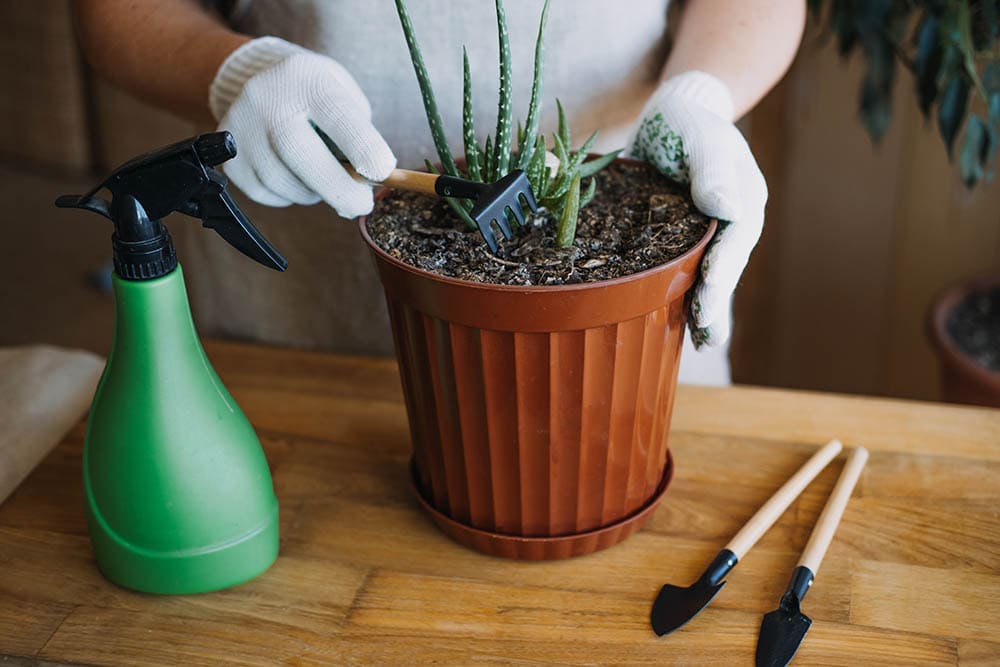How to Make Soil for Aloe Vera – What You Need to Know!
-
Pete Ortiz
- Last updated:

Aloe vera is a beneficial plant to have in your home. While it has many nutritional and topical benefits, it’s also incredibly easy to grow, making it a fantastic choice for novice growers.
When you’re getting started with your aloe or need to replant an existing plant, you might wonder exactly what kind of soil you can whip up. To help, we’ll discuss which soil types work best for aloe and how you can mix a batch of soil for your plants.
What Type of Soil Does Aloe Need?
Aloe Vera plants are generally easy to keep; they’re non-temperamental and resilient. These succulents grow best in a well-draining potting mix designed for cacti and succulents.
If you plan to make your own potting soil, you’ll need to sort out the perfect combination of perlite, lava rock, sandy soil, compost, and chunks of bark. A combo of roughly three of these components creates an ideal environment for your aloe vera to thrive.

Can You Use Gardening Soil?
While gardening soil or all-purpose house plant soil can be terrific for many of your indoor plants, the same does not extend to your aloe. All-purpose mixes are too dense, which can lead to root rot in your plant. If you purchase a premixed potting soil for aloe, always ensure it is explicitly designed for succulents.
Soil pH
Aloe vera requires a moderately neutral to slightly acidic pH to stay at its healthiest. These succulents prefer to remain on the acidic side, hovering around 6.0– 8.5 on the pH scale.
Soil Components
Aloe is not a plant that likes boggy or soggy soil. These plants require a drier, well-draining soil mix to grow to their full potential; a loamy mixture works best. Here is a good combination you can try out.
- 2 parts washed construction sand, pumice, or perlite
- 1 part manure or compost
- 1 part organic matter (shredded leaves or bark)
Potted Aloe: Buying a Premixed Soil
There are several options for commercial potting soil designed explicitly for aloe and other succulents.

Proper Container Size for Aloe
Once your aloe starts spawning tiny sprouts, growing roots out of the bottom of the pot, or falling over because it is too top-heavy to stand, repotting can help revamp the aesthetics and overall health of your plant.
If you are repotting your aloe plant, you’ll want to ensure it’s in the correct pot size. To change the soil and create a healthier foundation once your aloe gets too heavy, it’s best to replant roughly every 2 years. Repotting does several fantastic things for your plant. First, repotting replenishes the nutrients in the soil, helping your aloe plant eat better. It also creates more space for your plant to thrive.
Plus, who doesn’t like getting a new container for the home? There are so many aesthetically pleasing options online and in-store. Aloe does best in smaller pots that drain correctly. Orchid pots are an excellent example of an adequate container for your aloe plants. Ideally, the aloe plant should be between 5% and 10% larger than the pot it is in.
Conclusion
Growing a successful aloe plant is a relatively easy task, as you will soon find out. Once you master giving your aloe the right environment to grow, you will notice them flourish. Remember, the most crucial part is to create well-draining soil that will not hold too much water. While every potting soil recipe for aloe might differ slightly, the essential ingredients are the same.
Featured Image Credit: Inna_Kandybka, Shutterstock
Contents


